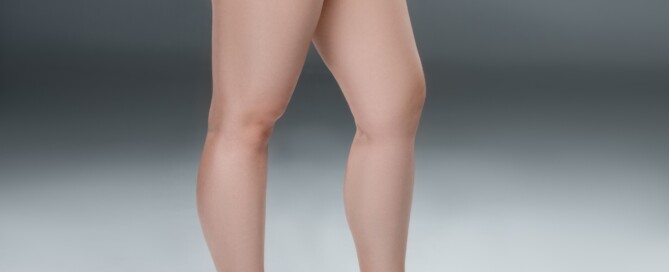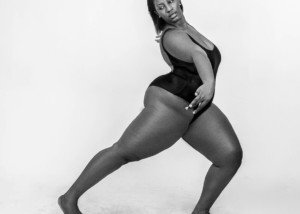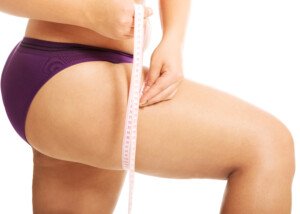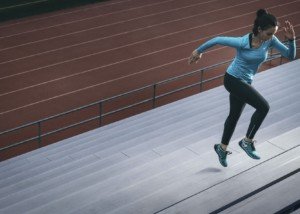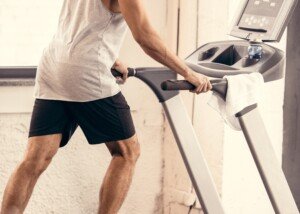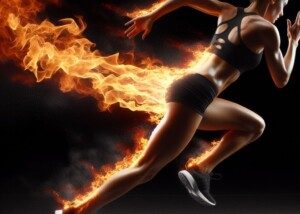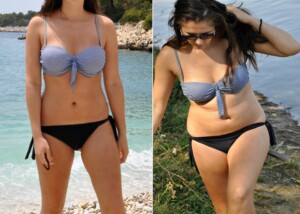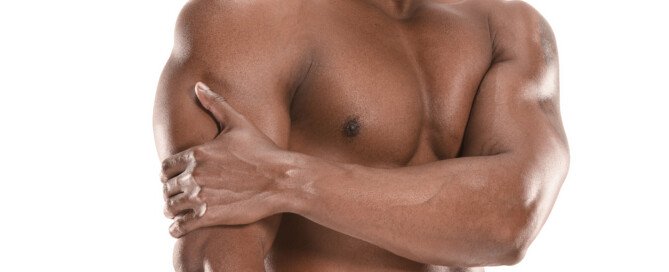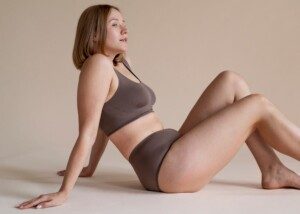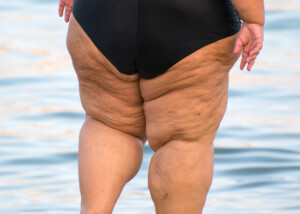Can a Dance Class Really Get Rid of Thunder Thigh Fat?
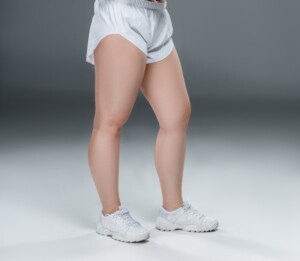
If you have the classic thunder thighs, don’t count on mere dance classes to slash off this unsightly fat; there are much better ways to accomplish this!
Unfortunately, the dancing approach is one that many people take for stripping off fat, and one that may even be suggested by some fitness professionals.
I’m not one of them if the goal is to “get rid of” big thighs. Dance classes are not at the top of the list for this goal.
Dance fitness classes don’t focus on working thighs.
There are some muscles that may get worked hard during dance fitness classes, but the thighs simply don’t.
The upper body might get a decent workout, the midsection might be worked some as well, and the cardiovascular system can definitely benefit, but all these areas of the body are actively engaged and the thighs aren’t.
There might be a few dance aerobics moves that work the thighs for a bit, but that’s just not enough exercise to slash the fat in thunder thighs.
Getting rid of thunder thighs requires more than dance fitness.
Getting rid of thunder thighs requires working the quads and the hamstrings.
For effectiveness, this should be done using weighted exercises, like the leg press, dumbbell squat, barbell squat and deadlift.
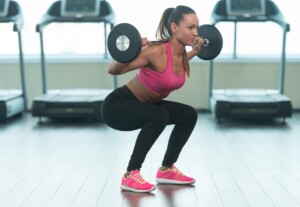
Back squat. Shutterstock/Jasminko Ibrakovic
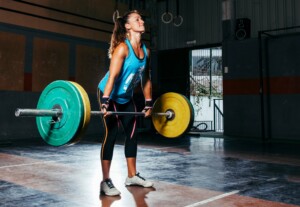
Deadlift. Freepik.com
Walking lunges, while you hold medium to heavy weights, are also valuable — as long as the weight isn’t so heavy that it interferes with proper form and full range of motion.
These exercises target the thighs specifically, toning the muscle and increasing the blood flow so that the fat is burned.
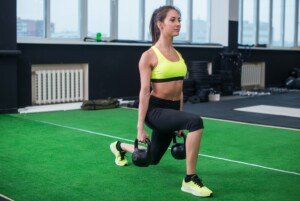
Weighted walking lunge. Shutterstock/Undrey
But these exercises also, when done intensely, incite a hormonal response that causes your body to suck the fat out any big fat cells all throughout your body, so that you get leaner overall.
Dance Classes Will Not Cure Thunder Thighs
Using dance fitness classes as the cure to thunder thighs is simply not a good suggestion.
These classes are better reserved for an aerobic workout to benefit heart health. You’ll get a training effect for your cardiovascular system. But this doesn’t translate to blasting out the fat in your hefty thighs.
So if you enjoy dance classes for the aerobic component, keep taking them. But to get rid of the thunder in your legs, you need to do more.
Those who have thunder thighs should do exercises specifically for the lower body in addition to their dance classes: intense compound weightlifting routines.
This includes sled pushing as well. This will force your entire lower body (and some upper body) to work like it has never worked before.
To maximize the fat-burn all throughout your body, include upper body strength training that targets the back and chest.

Lat pull-down for the back.
These large muscles will burn fat for recovery energy — which will partially come from your “thunder” thighs.
 Lorra Garrick is a former personal trainer certified through the American Council on Exercise. At Bally Total Fitness she trained women and men of all ages for fat loss, muscle building, fitness and improved health.
Lorra Garrick is a former personal trainer certified through the American Council on Exercise. At Bally Total Fitness she trained women and men of all ages for fat loss, muscle building, fitness and improved health.
.
Top image: Depositphotos.com
Trouble Falling Asleep? Losing Belly Fat Can Help

If insomnia plagues you–and you happen to have a fatty belly–losing some of that fat can help you sleep more like a baby.
Say so-long to your trouble sleeping. (more…)
Why Women Should Strengthen Their Hand Grip & How

A woman with a strong pair of hands that can grip tightly will have so much more confidence–not just in everyday tasks, but if she should ever find herself in a threatening situation. (more…)
Should Restaurant Servers Do Cardio Exercise Sessions ?

No matter how much walking you do as a server & how tired your feet ache at the end of a shift, your body still needs aerobic workout sessions–structured time set aside specifically for this. (more…)
How Fast Should Walking Speed Be on a Treadmill ?

Ever wonder what that fine line is when a walking speed on a treadmill should transition to jogging? Just HOW fast should someone walk on a treadmill?
Walking, either on a treadmill or outdoors, is one of the safest forms of exercise and highly recommended by doctors.
The irony is that the person who’s wondering how fast he or she should walk on a treadmill, might think nothing of ambulating briskly over a long distance at an airport to catch a plane.
Or, they might walk quite fast in an attempt to make a meeting that’s at the other side of the building they work in.
But on a treadmill, suddenly, the idea of brisk walking becomes a concern.
Reassure yourself that walking is as natural as drinking water.
The human body was engineered to walk, including briskly, and including up hills. This is how ancient man survived.
In fact, people did a heck of a lot of walking up to the time that cars were invented.
I honestly cannot think of one medical condition in which this fundamental form of movement can hurt a person, with the exception of orthopedic injuries, and afflictions such as osteoarthritis.
But even people with diabetes neuropathy, peripheral vascular disease and emphysema will benefit tremendously from walking.
So how fast would you like to know you can walk on a treadmill?
- How fast do you normally move in day-to-day life?
- Does brisk ambulation bring on hip or knee pain?
If so, you need to see an orthopedic medical professional. Did you recently sprain an ankle? Limit your walking.
Do you have plantar fasciitis? Same thing during flare-ups: Limit walking.
If your joints are fine and you have no injuries, then exercise away. If you feel dizzy during your session, get off the machine.
It’s possible your blood sugar is low, or that you may even be pregnant.
It’s also possible your body just isn’t used to walking on a moving belt.
Do not hold onto the machine, as this will not solve the underlying issue.
If this popular exercise brings on nausea or dizziness, stop and re-evaluate your eating habits and water intake.
Medications can also cause these side effects. If you’re pregnant, treadmill use is perfectly safe to do as long as you feel fine. Talk to your OB/GYN about that.
What’s most important is not how fast you should move on a treadmill, but your form.
You absolutely should not cling onto the machine when walking. Here are 10 reasons never to hold onto a treadmill.
Walk fast enough on a treadmill to get the heart rate up.
Swing arms and focus on good posture and breathing.
• Don’t slam your feet.
• Relax and let your body fall into its natural stride.
• If walking fast on a treadmill fails to get your heart rate up much, then either add an incline (but not so much that you’re forced to hold on), or transition to jogging.
• Don’t obsess about heart rate, and when you do take it, it’s more accurate to take it via feeling for your pulse while at rest, rather than assuming that the machine’s interpretation is correct.
Put a challenge on yourself: Train to work up to maintaining a 4 mph pace on a treadmill — without holding on.
That’s a pretty fast clip, but at the gym where I had worked as a personal trainer, I always saw a man, age 72, spend an entire hour walking 4 mph — without holding on!
 Lorra Garrick is a former personal trainer certified through the American Council on Exercise. At Bally Total Fitness she trained women and men of all ages for fat loss, muscle building, fitness and improved health.
Lorra Garrick is a former personal trainer certified through the American Council on Exercise. At Bally Total Fitness she trained women and men of all ages for fat loss, muscle building, fitness and improved health.
Stopped Losing Weight? Don’t Blame Genes; It’s Your Diet

Don’t chalk your stalled weight loss up to body type or genes.
There are several dietary reasons why the scale is now stuck at that still-too-big number.
When I was a personal trainer at a gym some years ago, I frequently counseled clients on nutrition and the reasons for weight loss stalls.
Not Eating Enough

Freepik.com,/schantalao
Significant calorie restriction may at first result in weight loss, making clothes fit looser, but the body doesn’t take long to start “panicking” and go into the so-called starvation response.
Stored body fat becomes harder to lose, to protect the body from what it “thinks” is a severe food shortage. We are hardwired for this response.
So why doesn’t it work in underdeveloped nations where multitudes of people starve to death or in developed countries where anorexia nervosa seems to be on the rise?
The severity of the typical dieter’s calorie shortage isn’t extreme enough to cause blatant wasting away of muscle and bone and impair organ function.
For some people, calorie restriction in the dieting range, rather than underdeveloped-country or anorexia nervosa range, may result in the weight loss eventually stopping.
Long Periods Between Eating
Long periods between eating can dip a person’s energy level and result in subdued physical activity: a smaller calorie expenditure. It may also slow metabolism.
Eating every three hours can spike energy levels in those who feel fatigued.
Unknowingly Adding More Food
You’ve lost sight of what you’ve been eating, and the diet has now increased in calories, causing you to stop losing weight.
Re-examine your portions including how much dressing or sauce you’ve been using.
Eating at the Wrong Times
Are you now eating cheat meals late at night, when metabolism has slowed down and there’s no activity to burn off the food?
Diet Is Not Effective at Losing the Desired Number of Pounds
It’s possible that the weight loss has stopped because you’re still overeating, even though initially, there was some weight loss.
What if you’ve gone through the above list, made the corrections, and are still stuck at a weight loss plateau?
“If you stop losing weight after being on a healthy diet, it could be possibly because of certain foods causing inflammation to your cells and tissues,” Prajakta Apte, RDN, owner and founder of Right Nutrition Works who helps people create a healthier lifestyle.
“Inflammation can be an origin of you having challenges in weight loss,” continues Apte.
“You are not what you eat, but you are what you digest. A simple blood test can solve this problem.”
The blood test is called C-reactive protein and can be ordered by your doctor.
Don’t go overboard by going on a starvation diet. Practice portion control, limit processed foods and fast foods, and engage in strength training and high intensity interval training to fire up metabolism.
 Prajakta Apte is the author of the eBook “Overcoming Nutrition Roadblocks.” Her personalized approach to nutrition therapies helps treat root causes of conditions such as type 2 diabetes, high cholesterol, GI disorders, hypertension and many more.
Prajakta Apte is the author of the eBook “Overcoming Nutrition Roadblocks.” Her personalized approach to nutrition therapies helps treat root causes of conditions such as type 2 diabetes, high cholesterol, GI disorders, hypertension and many more.
 Lorra Garrick is a former personal trainer certified through the American Council on Exercise. At Bally Total Fitness she trained women and men of all ages for fat loss, muscle building, fitness and improved health.
Lorra Garrick is a former personal trainer certified through the American Council on Exercise. At Bally Total Fitness she trained women and men of all ages for fat loss, muscle building, fitness and improved health.
.
Top image: Depositphotos.com
Burn Fat, not Muscle with HIIT on a Treadmill
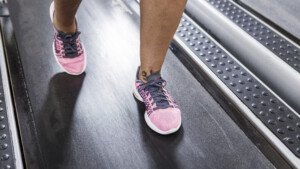
You no longer have to avoid doing aerobic exercise in the name of preserving the muscle you’ve worked so hard to build. (more…)
Best Fat Burning Cardio for Big Muscles

Men with big muscles will want to burn lots of fat to show off those giant muscles as much as possible. Here is how.
Additionally, those with big muscles will also want to slash their body fat levels so that their waist gets smaller — which will make their muscles appear even bigger.
I’ve noticed that men with hypertrophic builds seem to prefer the elliptical machine for their fat burning workouts more than any other cardio equipment.
Why the elliptical machine for burning fat?
The elliptical machine is very popular for all kinds of people.
But it’s especially favored among men with huge muscles.
Muscle is heavy. Perhaps it hurts their knees to jog on a treadmill or around the gym’s track.
As for walking on a treadmill, perhaps heavily muscled men figure that walking won’t burn enough fat or get the heart rate going, so they choose the elliptical to get a faster motion with their legs.
But faster doesn’t always mean more fat burning.
Walking on a treadmill at an incline will burn tremendous amounts of fat – but only if you don’t hold onto the equipment!

Wrong. Do not hold on, especially if you want to burn fat. Dreamstime.com/Aleksandar Todorovic.
This “no holding on” rule applies as much to men with huge muscle as it does to anyone else wishing to burn up the fat.
If you’re a big guy with lots of enviable muscle mass, but want to further shave down your body fat percentage, here is a recommendation:
If you use the elliptical machine, keep your hands off the machine.
Nobody says you must hold onto those arm cranks.
Let your arms move at your sides in synch with your body, as you would if you were jogging along the beach.
Contrary to popular belief, gluing your hands to the arm cranks will NOT burn more calories.
If the arm cranks are a distraction, use an elliptical that doesn’t have this gimmick if one is available at the gym.
Revolving staircase: Again, hands off the equipment.
Imagine climbing flights of stairs for burning fat, whether those flights are in a high rise building or outdoors.
You wouldn’t be leaning against anything or grasping at anything.
Use this logic when using the revolving staircase.
Treadmill walking or jogging.
The man with the big muscles can burn a lot of fat if he uses the treadmill correctly.
The first step is to walk like a real man: Keep your hands off the treadmill’s rails or the bar in front.
Used the rails only to memontarily steady yourself.
If you use the incline, keep your hands at your sides anyways, as you would if you were walking hills outdoors to burn fat.
The guy with the big muscles should also consider jogging on the treadmill. Start slowly at first.
The best way to use cardio to burn fat is to engage in HIIT style training.
HIIT not only burns the most fat, but it actually takes less time to do than traditional “long slow” cardio.
 Lorra Garrick is a former personal trainer certified through the American Council on Exercise. At Bally Total Fitness she trained women and men of all ages for fat loss, muscle building, fitness and improved health.
Lorra Garrick is a former personal trainer certified through the American Council on Exercise. At Bally Total Fitness she trained women and men of all ages for fat loss, muscle building, fitness and improved health.
.
Top image: Freepik.com
Are You Fat but Think Strength Training Will Make You Bigger?
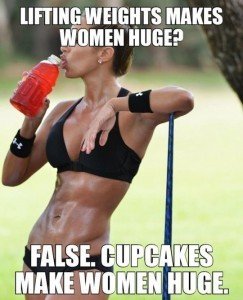
The most important thing an obese woman can do is stop believing that training with weights will make her body even bigger.
NOT TRUE! Stop thinking like this!
The thought that lifting weights makes obese women bigger is a misconception.
When I was personal trainer I often explained to overweight women that strength training will shrink their bodies, not enlarge them.
I explained: “You need to lift heavy to blast fat away, but that heaviness is light to men who lift weights.”
It’s a misconception that has caused many overweight women to fail to accomplish their goals, so it needs to be put to an end.
Looking at pictures of massively muscular bodybuilders doesn’t help the situation at all, but what about them?
They lift weights and get bigger and bigger.
Wouldn’t that make this type of exercise something obese women should avoid?
Why Strength Training Will Not Make an Obese Woman Bigger
Muscle is denser than fat and it burns up fat. Somehow, when obese women think of lifting weights, they picture big muscles being created under their fat, making them bigger, and it just doesn’t happen that way.
- Lifting weights makes obese women smaller, not bulky.
- Fat actually takes up more space than muscle.
Strength training adds lean shapely muscle; it does NOT add more fat!
If an obese women succeeded in replacing all their fat with muscle, still remaining at the same weight, they would be much smaller.
However, the rate by which fat is burned off by muscle means they most likely won’t remain at the same weight. They’ll lose weight instead.
Lifting weights is actually beneficial for obese women.
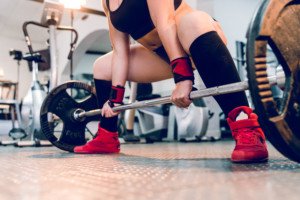
The deadlift exercise. Shutterstock/Miljan Zivkovic
There is almost nothing that burns off fat quite like muscle does.
As you build muscle, your metabolism increases, meaning that the excess weight that’s burn continues around the clock, even in your sleep because the muscle stays with you.
Every time an obese women lifts weights, she’s raising her metabolism to a higher level that can be permanent, as long as she continues to exercise on a regular basis.
It can help her reach her goals in record time.
Don’t fall for the crazy myth that overweight women will increase their body size from working out with weights — even heavy resistance, for that matter.
Why let such mixed up thinking keep you from having the body of your dreams?

